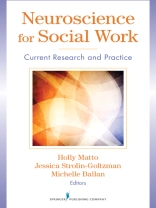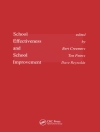This clear and accessible guideówritten by social workers for social workersódescribes the most current developments in neuroscience and their practical applications for social work in education, child welfare, health, mental health, and criminal justice settings. The contributions of social work experts in these key areas of practice make this vast and ever-expanding body of neuroscientific knowledge easily understandable, with specific relevance to understanding the impact of the environment on neural mechanisms and human life course trajectories.
The text examines how neuroimaging can be used to examine psychosocial treatment efficacy, discusses cross-system programmatic and policy implications that respond to the way in which toxic environments and early disrupted attachment affect brain and behavior, and addresses the importance of bioethics to inform the integration of neuroscience into social work practice.
This is the only text on this topic with chapters organized around five practice settings and embedded with application skills across micro, mezzo, and macro levels. Each chapter includes an overview of the latest scientific research pertaining to the topic and discusses implications for assessment, prevention, intervention, policy, research, and ethics. Real-world case studies in each chapter enhance practice applications.
Key Features:- Describes the latest applications of neuroscience across social work settings in education, child welfare, health, mental health, and criminal justice
- Examines latest neuroscientific research for each topic and its implications for assessment, prevention, intervention, policy issues, research, and ethical/legal issues
- Draws clear practical implications in each chapter
- Written by social workers for social workers
- Includes the contributions of noted social work researchers, faculty, and practitioners
Зміст
‘
Contributors ix
Foreword Julie Cooper Altman and Richard A. Altman xiii
Preface xxv
SECTION A: NEUROSCIENTIFIC IMPLICATIONS FOR GENERALIST SOCIAL WORK PRACTICE
Chapter 1. Introduction 1 Holly C. Matto, Jessica Strolin-Goltzman, and Michelle S. Ballan
Chapter 2. Your Brain on Empathy: Implications for Social Work Practice 9 Karen E. Gerdes, Elizabeth A. Segal, and Jordan K. Harmon
Chapter 3. Mirror Neurons 37 Rosemary L. Farmer
Chapter 4. Use of Meditative Dialogue to Cultivate Compassion and Empathy With Survivors of Complex Childhood Trauma 57 Susan A. Lord
Chapter 5. Traumatic Stress Response Transactions on Development 69 Jose Carbajal and Regina T. P. Aguirre
Chapter 6. F.I.T. Camp: A Biopsychosocial Model of Positive Youth Development for At-Risk Adolescents 87 Raquel Warley, DeíShay Thomas, and Monica Harris
SECTION B: NEUROSCIENTIFIC IMPLICATIONS FOR SOCIAL WORK PRACTICE IN CHILD WELFARE AND EDUCATION
Chapter 7. Effects of Child Maltreatment on Brain Development 111 Kya Fawley-King and Emily C. Merz
Chapter 8. The Role of Neurobiology in Social Work Prac With Youth Transitioning From Foster Care Wendy B. Smith tice 141
Chapter 9. How Neuroscience Can Inform Educational Practices for Youth Involved in the Child Welf are
System 161 Haley Woodside-Jiron, Jessica Strolin-Goltzman, and Jesse C. Suter
Chapter 10. Using Neuroscience to Inform Social Work Practices in Schools for Children With Disabilities 177 Cristina Mogro-Wilson
Chapter 11. Management of Violence and Aggression in Schools 203 Alexa Smith-Osborne
SECTION C: NEUROSCIENTIFIC IMPLICATIONS FOR SOCIAL WORK PRACTICE IN HEALTH AND MENTAL HEALTH
Chapter 12. Substance Abuse 217 Holly C. Matto, Suzanne Brown, and Michelle S. Ballan
Chapter 13. Targeting Transdiagnostic Processes in Clinical Practice Through Mindfulness: Cognitive, Affective, and Neurobiological Perspectives 235 Eric L. Garland, Jaclyn Williams, Hillary Gale, Amber Kelly, and Matthew O. Howard
Chapter 14. Toxic Stress and Brain Development in Young Homeless Children 263 Nathan Hutto and Julianne Viola
Chapter 15. Traumatic Brain Injury and Military Families 279 Alexa Smith-Osborne
Chapter 16. Major Depression Is Systemic Inflammation 293 Jill Littrell
SECTION D: NEUROSCIENTIFIC IMPLICATIONS FOR SOCIAL WORK PRACTICE IN CRIMINAL JUSTICE
Chapter 17. Neuroscience of Risk-Taking in Adolescence 313 Michelle Evans-Chase
Chapter 18. Neurodevelopmental Approaches to Understanding
and Working With Adolescents in the Juvenile
Justice System 335
George S. Leibowitz
Chapter 19. Adult Criminal Justice System 355 Elizabeth D. Hutchison
Index 379
‘Про автора
Michelle S. Ballan, Ph D, is the director of the Columbia University Disability Research Group and is an investigator on several grants focused on sexuality and interpersonal violence among individuals with disabilities.












